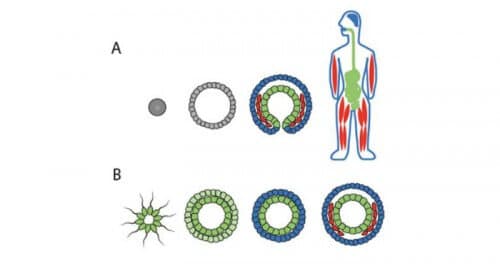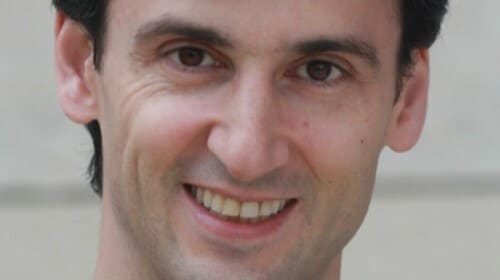Surprising findings about fetal development may help medicine

Everyone who reads "The Little Light", started his life from one and the same cell. A fertilized egg. This cell divided to make two identical copies of itself, and these divided again and again and again. Only when the tiny embryo was a mass of thousands of identical cells did the process of differentiation begin, at the end of which a huge variety of cells, different in size, shape and function, were created from those identical cells: skin cells, nerves, blood cells, muscle, liver and so on. This process is not unique to humans, nor even to mammals. It exists in almost all multicellular creatures: from an elephant to a dragonfly, from a snail to a potato. The differentiation process is not direct - there are many intermediate stages between the identical cells and the fertilized egg, and the muscle, blood or nerve cells that are formed at the end. In the first stage of the differentiation process, three layers of cells are formed in the embryo. the ectoderm (ectoderm, from the Greek words "ecto" - external and "derma" - skin), from which the skin and the nervous system develop; mesoderm (mesoderm, i.e. middle layer), from whose cells the skeleton, muscles and blood cells are formed, among other things; and endoderm (endoderm, the inner layer), which later produces the respiratory system, the digestive system, the liver and the glands). The modern study of embryonic development began as early as the 19th century, however, until now the researchers could not say the order in which these layers were formed. More precisely, the researchers were not really interested in this issue either.
A question of activity
The one who did show interest in the issue is Prof. Itai Yanai, a researcher at the Technion's biology faculty. Yanai approached to examine the interest in the technology he developed with his colleagues about two years ago, and it allows examining the function of the cells with great precision. As we mentioned earlier, all cells develop from the same cell, and they all also carry the same genetic information - the same DNA - which includes approximately 20,000 genes in humans. So how do they develop into such a wide variety of cells that are so different from each other? Each of the cells activates different genes. "You can imagine it as a room, the walls of which have 20,000 different light switches," Yanai explains. "In each room, the light bulbs turn on and off in different constellations, and this is how the huge variety of cells is obtained." The genes are actually instructions for making proteins. But the instructions are not carried out directly from the program itself, which is the DNA in the cell nucleus, but a copy of it is created. The copy, known as mRNA, comes out of the nucleus and is sent to be processed in the organelles responsible for the production of proteins. With the method developed by Yanai, CEL-Seq, the amount of mRNA of each gene is tested at a certain moment. The more copies of that gene, the more active it is. This technology, combined with powerful data processing, allows researchers to identify with great precision the active genes in the cell at any given time, and thus better understand a long series of biological processes. Yanai and his research group - Tamar Shamshoni, Martin Feder, Michal Levin and Brian Hall - used it to track the process of embryonic development.
What does the worm want?
In humans, the formation of the layers in the fetus occurs in the third week of pregnancy. To simplify the processes, the researchers turned to a much simpler creature: Caenorhabditis elegans, a tiny worm that is about one millimeter in size, and whose body consists of a total of 959 cells (compared to about 100 trillion cells in humans). Despite the simple appearance of C. elegans, its cells are quite complex, and contain about 19,000 genes - much closer to the human genome than one might expect. This combination of simplicity and complexity makes the tiny worm a very popular animal with biologists, who use it in many basic studies. These are joined by another considerable practical advantage. The worm completes its embryonic development in only 12 hours, which makes working with it very easy. Yanai and his colleagues followed the expression of the genes in the embryonic cells of the worm, and through it they were able to identify the order of formation of the cell layers: the endoderm - the inner layer - is formed first, followed by the mesoderm and the ectoderm. This finding, published in the journal Nature, may sound very technical, but it reveals very interesting information about the relationship between the single embryo and the evolution of the entire species.
Evolution in tiny Anfin

Ernst Haeckel (Haeckel) was a German biologist who worked in the late 19th and early 20th centuries. He discovered and described thousands of animal species, created an evolutionary genealogy of the natural world, and coined many terms that are still in use today (such as stem cells). Hakel, like others before him, noticed that the processes that take place during the development of an embryo - any embryo - reflect evolution in a certain way: it starts from a single cell, gradually becomes a multicellular creature composed of identical cells and later develops into a creature composed of cells with different functions, arranged in tissues and organs. The development process is accompanied by changes in shape, such as the development of symmetry, the formation of limbs and the development of the brain. Similar processes can be seen in the evolution of animals: after millions of years of unicellular creatures, simple multicellular creatures appeared. Gradually, more complex animals were created, and creatures with circular symmetry, such as jellyfish for example, evolved into creatures with bilateral symmetry. As we progress up the evolutionary tree, animals with moving limbs appear, and the more advanced the animal is, the greater the concentration of nerves in the front part of its body, i.e. the head. Hakel described the process in one catchy sentence: ontogenesis reflects phylogenesis. That is, the (embryonic) development of the individual reflects the (evolutionary) development of the entire species. Over the years, many scientists have disapproved of the theory, after many deviations from it were found in the animal world. However, the findings of Yanai and his colleagues indicate that there may be something to it after all, at least at the cellular level. According to them, the endoderm layer, which they proved to be the first to form, originates from those ancient single-celled creatures from which all life evolved. The cells in this layer are the ones that express the earliest and most conserved genes in evolution, responsible for the most basic processes of life.
A natural continuation
"One of the fun things about science is the opportunity to illustrate the importance of issues that so far no one has thought to check," says Yanai. "We thought that the question of the order of formation of the layers in the embryo was important, and indeed we saw that it had many consequences. We show that the organism is subject to its historical process. What happened 500 million years ago still affects him." Yanai hopes that the new knowledge accumulated from the research will make it possible to understand which processes in the cell are fixed due to their evolutionary importance, and which processes can be influenced without harming the cell, in order to improve the condition of the organism. These days, Yanai is staying at the American Harvard University, where he harnesses the method he developed, CEL-Seq, to study the cancer process. "Cancer tumors are also cells that develop and grow, and the changes in gene expression during their development are not fundamentally different from those that occur during embryonic development. Therefore, cancer research is a natural continuation of my research."

3 תגובות
pleasure. Thanks.
And her body consists of a total of 959 cells. 959 = 7*137.
Maybe this multiple implies a certain relationship in the structure of the worm?
(I'm a fan of numbers what to do?).
Interesting article!